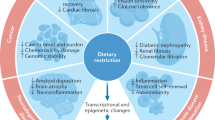Abstract
It is concluded that dietary restriction will extend the life of all species in the Animalia Kingdom, including the human species. This conclusion is based on the fact that hormesis is a component of the life-extending action and the other anti-aging effects of dietary restriction. It is also concluded that given the currently available database, it is not possible to predict the quantitative effect of dietary restriction on the human life span.
Similar content being viewed by others
References
Anderson RM, Bitterman KJ, Wood JG, Medvedik O, Sinclair DA (2003) Nicotinamide and PNC1 govern the lifespan extension by caloric restriction in Saccharomyces cervisiae. Nature 423:181–185
Calabrese EJ, Baldwin LA (1998) Hormesis as a biological hypothesis. Environ Health 106(Suppl 1):357–362
Harrison DE, Archer JR (1987) Genetic differences in effects of food restriction on aging mice. J Nutr 117:376–382
Lopez-Torres M, Gredilla R, Sanz A, Barja G (2002) Influence of aging and long-term calorie restriction on oxygen radical generation and oxidative DNA damage in rat liver. Free Radic Biol Med 32:882–889
Masoro EJ (1998) Hormesis and the antiaging action of caloric restriction. Exp Gerontol 33:61–66
Masoro EJ (2002) Caloric restriction: a key to understanding and modulating aging. Elsevier, Amsterdam
Matsuo S, Gomi F, Kuramoto K, Sagai M (1993) Food restriction suppresses an age-dependent increase in exhalation rate of pentane from rats: a longitudinal study. J Gerontol: Biol Sci 48:B133–B138
Rattan SIS (2001) Applying hormesis in aging research and therapy. Hum Exp Toxicol 20:281–286
Rattan SIS (2004) Aging, anti-aging and hormesis. Mech Ageing Dev 125:285–289
Reed MJ, Penn PE, Li Y, Birnbaum R, Vernon RB, Johnson TS, Pendergrass WR, Sage EH, Abrass IB, Wolf NS (1996) Enhanced cell proliferation and biosynthesis mediate improved wound repair in refed, calorie-restricted mice. Mech Ageing Dev 89:21–41
Reiser K, McGee C, Rucker R, McDonald R (1995) Effects of aging and caloric restriction on extracellular matrix biosynthesis in a model of injury repair in rats. J Gerontol: Biol Sci 50A:B40–B57
Sabatino F, Masoro EJ, McMahan CA, Kuhn RW (1991) An assessment of the role of the glucocorticoid system in aging processes and in the action of food restriction. J Gerontol: Biol Sci 46:B171–B179
Sell DR (1997) Ageing promotes the increase of early glycation Amadori product as assessed by ε-N-(2-furoylmethyl)-l-lysine (furosine) levels in rodent skin. Mech Ageing Dev 95:81–89
Sohal RS, Ku H-H, Agarwal S, Forster MJ, Lal H (1994) Oxidative damage, mitochondrial oxidant generation, and antioxidant defenses. Mech Ageing Dev 74: 121–133
Yu BP (1996) Aging and oxidative stress: Modulation by dietary restriction. Free Radic Biol Med 21:651–668
Author information
Authors and Affiliations
Corresponding author
Rights and permissions
About this article
Cite this article
Masoro, E.J. Dietary restriction-induced life extension: a broadly based biological phenomenon. Biogerontology 7, 153–155 (2006). https://doi.org/10.1007/s10522-006-9015-0
Received:
Accepted:
Published:
Issue Date:
DOI: https://doi.org/10.1007/s10522-006-9015-0




